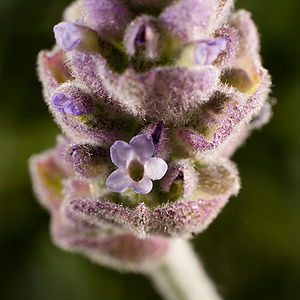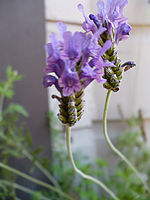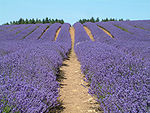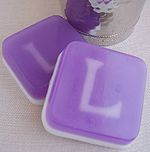English lavender
| English lavender |
|---|

|
| Scientific Classification |
|
| Binomial Name |
|
L. angustifolia |
| A cute little lavender flower tucked away in a larger bloom. |
The scientific name of English Lavender is Lavandula angustifolia. There are over 100 varieties of Lavender. It is native to Somaliland, Mediterranean, Canary Islands, India, and France. A scent of Lavender symbolizes purity. Lavenders preserve a tranquil mind so people can sleep in comfort. In 17th-century, Lavenders were well-known by medicines. They maintain one's health and are good for suppression, throe, and purgation. Lavenders are effective for flu, myalgia, stress, hypochondria, insomnia, headache, dyspepsia, dermatitis, and tumor. Many Lavenders grow well in warm weather and on the dry ground with few gravels.
Anatomy
Most Lavenders grow 30-60cm(2-3ft) in height and it can be about 90cm in height. They have white hairs and their stems are square. They have a double seed-leaf which means they are a dicotyledon. Lavender leaves can be 4cm in length and 4-6mm in width. They don't have a sessile leaf, most have fine hairs. Lavender flowers bloom violet or white in June-September. Most Lavenders have violet flowers but sometimes we can find white, blue, pink, or yellow flowers. The hairs of Lavender between petal and stem have oil that makes the scent of the flowers.
Reproduction
Lavenders reproduce their seed by sowing and planting. The planting plants don't make the seed to propagate. They divide their roots and shed them to propagate. The people keep out of sowing because it can make different qualities of hybrids. After a planting, Lavenders take root in the ground in 2 weeks. Lavenders are weak in high temperature and humidity, so their flower stalks have to be cut in summer. They have to be cared often in winter.
Ecology
Most of the Lavenders live and take care by the growers. They have to be cared for by growers so that they can grow well. Lavenders can't live in high temperatures and in low temperatures. They have to live in a suitable temperature and be well ventilated. The Lavenders can stand in a drought but can't stand in the rainy season, so the grower has care for them a lot. After the Lavenders grow and bloom their flowers, the growers cut them all and sell them. Then the people use the Lavenders in many ways. Such as to make soaps, perfumes, candles, teas, cosmetic, shampoos, medicines, and decorations.
Homemade Lavender soap
A lavender soap is easy to make at home. The ingredient that you need is 32 ounces distilled water, 12 ounces sodium hydroxide, 38 ounces vegetable shortening, 2 tablespoons of colorant, 1-2 ounces of lavender essential oil. First thing we have to do is mix 1/4 tsp. of oxides with 6 tbs. of little oil. The important thing to start mixing a soap is to get everything organized, measured, and ready to go. Second thing to do is add the lye water to the bath and stir it slowly. After that, pour them into a other large bowl. Then, add colorant and lavender essential oil. Mix them and slowly pour them into the mold and put a towel on top of the mold. It will take 24 hours to make the soap cooled. After it has completely cooled, unfold and cut it. Then cure it for several weeks. Lavender soap is good for skin ailments such as acne, dermatitis, and tumor.
Gallery
 Browse |
References
- Lavender www.wikipedia.com. 23 April 2009.
- Lavender (Lavandula angustifolia) www.gardenguides.com. Barbara Fahs, Garden Guides Contributor.
- The English Lavenders www.mountainvalleygrowers.com. Mountain Valley Growers.
- Lavender:Information on uses, dosage & side effects www.healthline.com.
- English Lavender www.ext.vt.edu. Diane Relf, Extension Specialist. April 1997.
- Lavender Medicine www.umm.edu. University of Maryland Medical Center.
- Havenhill Lavender www.havenhilllavender.com.
- Lavender Tips www.lavenderwind.com.
- Lavender-Mint Soap Recipe candleandsoap.about.com. David Fisher.
- Soap Making www.mountainvalleygrowers.com. Mountain Valley Growers, Inc.
See Also








